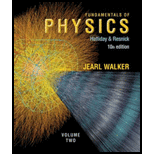
(a) A stationary particle 1 decays into parties 2 and 3, which move off with equal but oppositely directed momenta. Show that the kinetic energy K2 of particle 2 is given by
where E1, E2, and E3 are the rest energies of the particles.
(b) A stationary positive pion π+ (rest energy 139.6 MeV) can decay to an antimuon μ+ (rest energy 105.7 MeV) and a neutrino v (rest energy approximately 0). What is the resulting kinetic energy of the antimuon?
Want to see the full answer?
Check out a sample textbook solution
Chapter 44 Solutions
Fundamentals of Physics
Additional Science Textbook Solutions
General, Organic, and Biological Chemistry: Structures of Life (5th Edition)
Chemistry: Structure and Properties (2nd Edition)
Anatomy & Physiology (6th Edition)
Human Biology: Concepts and Current Issues (8th Edition)
Organic Chemistry
Human Anatomy & Physiology (2nd Edition)
- No chatgpt pls will upvotearrow_forwardOne of the earliest video games to have a plot, Zork, measured distances in “Bloits” where 1 Bloit was defined as the distance the king’s favorite pet could run in one hour, 1,090 m. In the same game the king has a statue made that is 9.00 Bloits high. What is this in meters?arrow_forwardNo chatgpt pls will upvotearrow_forward
- No chatgpt pls will upvotearrow_forwardDefination of voltagearrow_forwardAt point A, 3.20 m from a small source of sound that is emitting uniformly in all directions, the intensity level is 58.0 dB. What is the intensity of the sound at A? How far from the source must you go so that the intensity is one-fourth of what it was at A? How far must you go so that the sound level is one-fourth of what it was at A?arrow_forward
- Make a plot of the acceleration of a ball that is thrown upward at 20 m/s subject to gravitation alone (no drag). Assume upward is the +y direction (and downward negative y).arrow_forwardLab Assignment #3 Vectors 2. Determine the magnitude and sense of the forces in cables A and B. 30° 30° 300KN 3. Determine the forces in members A and B of the following structure. 30° B 200kN Name: TA: 4. Determine the resultant of the three coplanar forces using vectors. F₁ =500N, F₂-800N, F, 900N, 0,-30°, 62-50° 30° 50° F₁ = 500N = 900N F₂ = 800Narrow_forwardLab Assignment #3 Vectors Name: TA: 1. With the equipment provided in the lab, determine the magnitude of vector A so the system is in static equilibrium. Perform the experiment as per the figure below and compare the calculated values with the numbers from the spring scale that corresponds to vector A. A Case 1: Vector B 40g Vector C 20g 0 = 30° Vector A = ? Case 2: Vector B 50g Vector C = 40g 0 = 53° Vector A ? Case 3: Vector B 50g Vector C 30g 0 = 37° Vector A = ?arrow_forward
- Three point-like charges are placed at the corners of an equilateral triangle as shown in the figure. Each side of the triangle has a length of 20.0 cm, and the point (A) is located half way between q1 and q2 along the side. Find the magnitude of the electric field at point (A). Let q1=-1.30 µC, q2=-4.20µC, and q3= +4.30 µC. __________________ N/Carrow_forwardNo chatgpt pls will upvotearrow_forwardNo chatgpt plsarrow_forward
 Classical Dynamics of Particles and SystemsPhysicsISBN:9780534408961Author:Stephen T. Thornton, Jerry B. MarionPublisher:Cengage Learning
Classical Dynamics of Particles and SystemsPhysicsISBN:9780534408961Author:Stephen T. Thornton, Jerry B. MarionPublisher:Cengage Learning Principles of Physics: A Calculus-Based TextPhysicsISBN:9781133104261Author:Raymond A. Serway, John W. JewettPublisher:Cengage Learning
Principles of Physics: A Calculus-Based TextPhysicsISBN:9781133104261Author:Raymond A. Serway, John W. JewettPublisher:Cengage Learning Modern PhysicsPhysicsISBN:9781111794378Author:Raymond A. Serway, Clement J. Moses, Curt A. MoyerPublisher:Cengage Learning
Modern PhysicsPhysicsISBN:9781111794378Author:Raymond A. Serway, Clement J. Moses, Curt A. MoyerPublisher:Cengage Learning Physics for Scientists and Engineers: Foundations...PhysicsISBN:9781133939146Author:Katz, Debora M.Publisher:Cengage Learning
Physics for Scientists and Engineers: Foundations...PhysicsISBN:9781133939146Author:Katz, Debora M.Publisher:Cengage Learning University Physics Volume 3PhysicsISBN:9781938168185Author:William Moebs, Jeff SannyPublisher:OpenStax
University Physics Volume 3PhysicsISBN:9781938168185Author:William Moebs, Jeff SannyPublisher:OpenStax College PhysicsPhysicsISBN:9781938168000Author:Paul Peter Urone, Roger HinrichsPublisher:OpenStax College
College PhysicsPhysicsISBN:9781938168000Author:Paul Peter Urone, Roger HinrichsPublisher:OpenStax College





